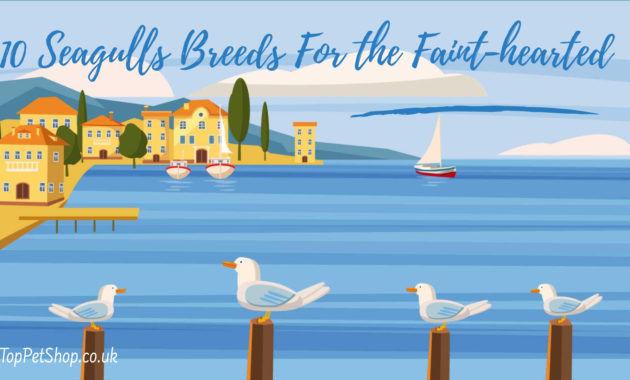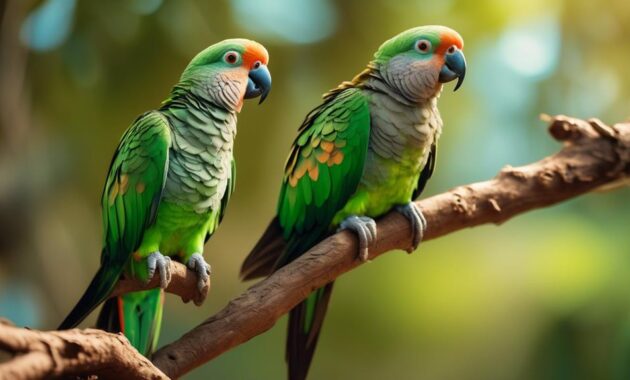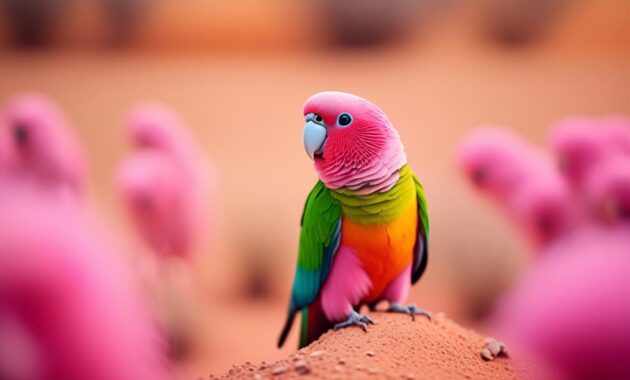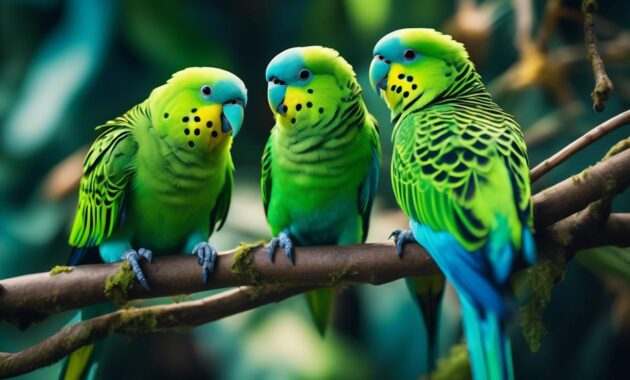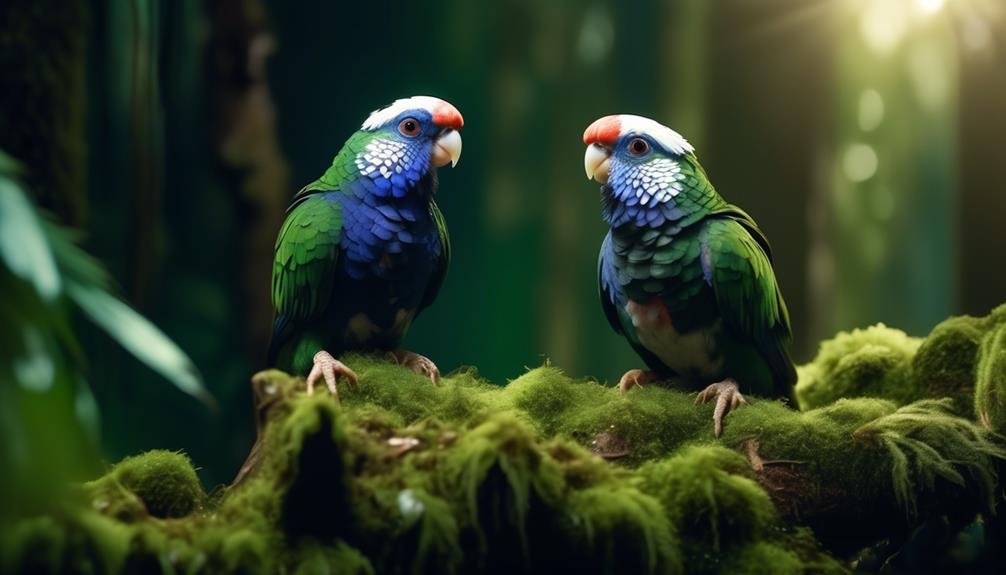
Are you ready to step into a world where enchantment meets the wild?
Picture this: a fascinating creature, the White Capped Pionus, gracefully navigating through the lush foliage of the forest. Its vibrant colors juxtaposed against the serene backdrop, capturing your attention and igniting your curiosity.
But that's just the beginning. As you delve further, you'll uncover the secrets of its captivating behavior, its intelligent nature, and the incredible bond it forms with its human companions.
Stay tuned as we uncover the wonders of the exotic White Capped Pionus, a forest companion like no other.
Key Takeaways
- The White Capped Pionus is a medium-sized bird with a distinctive white cap on its head and green plumage with blue on the wings and tail.
- They are native to the forests of Central and South America and can be found in countries like Costa Rica, Panama, Colombia, and Ecuador.
- White Capped Pionus are highly social birds that form strong pair bonds and enjoy interacting with their owners through play and mimicry.
- Their diet is omnivorous, consisting of fruits, seeds, nuts, berries, flowers, leafy greens, insects, and small invertebrates. They particularly enjoy eating corn.
Physical Characteristics
The White Capped Pionus is a medium-sized bird known for its distinctive physical characteristics. With an average length of 10 inches and weighing around 8 ounces, this bird has a white crown and a spot under its chin. Its breast feathers are typically a dim blue color, while its back and wings display a subtle gradient of green tones. The undertail is bright red, and it has a distinctive white cap on the top of its head.
The plumage is primarily green, with blue accents on the wings and tail. These unique features make the White Capped Pionus a visually captivating bird to have as a companion in the forest.
Habitat and Distribution
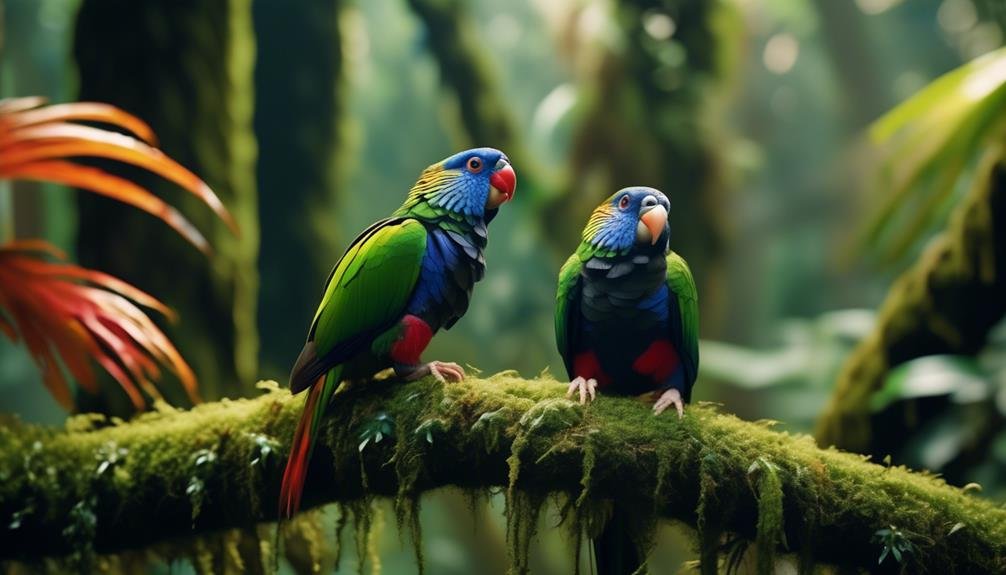
Native to the forests of Central and South America, the White Capped Pionus can be found in countries such as Costa Rica, Panama, Colombia, and Ecuador. These enchanting birds prefer humid and subtropical environments, inhabiting both lowland and montane forests. They can also be found in secondary growth and agricultural areas. With their adaptability, they've managed to thrive in a variety of habitats.
However, habitat loss due to deforestation poses a significant threat to their population. Despite this, the White Capped Pionus is currently classified as a species of least concern by the IUCN, as their populations remain stable in most of their range. Conservation efforts, such as captive breeding programs and regulation of trade, are in place to ensure their continued survival.
Behavior and Interaction
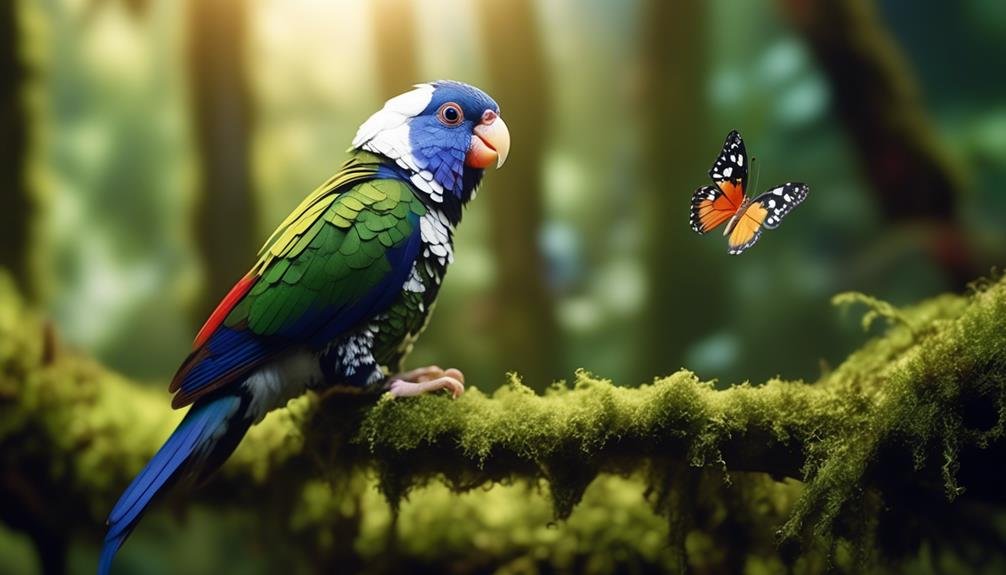
With their captivating personality and social nature, the White Capped Pionus is known for forming strong pair bonds and enjoying interactive play with their owners. Here are some key behaviors and interactions you can expect from these enchanting forest companions:
- Playfulness and Affection:
- White Capped Pionus are playful and enjoy interacting with their owners.
- They love playing games and spending quality time with their trusted person or household.
- Communication and Intelligence:
- These birds communicate through a range of vocalizations, including whistling and mimicking sounds.
- They're intelligent and enjoy interactive toys and puzzles that stimulate their curious minds.
Diet and Feeding

To maintain the health and well-being of your White Capped Pionus, it's crucial to provide them with a balanced and varied diet. These birds have an omnivorous diet, feeding on a variety of fruits, seeds, nuts, and berries. They also enjoy eating flowers, buds, and leafy greens. Occasionally, they'll eat insects and small invertebrates.
It's important to offer them a diverse range of foods to ensure they receive all the necessary nutrients. They particularly love eating corn, especially corn on the cob. Make sure to provide fresh food daily and remove any uneaten portions to maintain their hygiene.
It's also recommended to consult with an avian veterinarian to ensure you're meeting their dietary needs and to address any specific concerns.
Conservation Status and Care
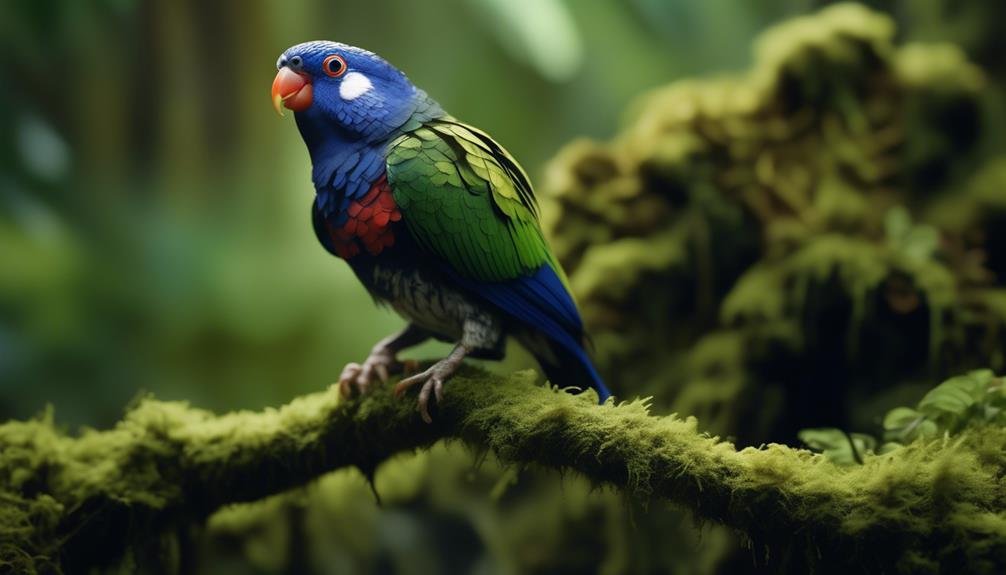
The White Capped Pionus, classified as a species of least concern, requires proper care and attention to ensure their well-being and longevity. Here are some important points to consider:
Conservation:
- Populations of White Capped Pionus are stable in most of their range, but habitat loss due to deforestation poses a significant threat.
- Captive breeding programs play a crucial role in maintaining genetic diversity and supporting the species' population.
- The trade of White Capped Pionus is regulated by CITES (Convention on International Trade in Endangered Species) to prevent overexploitation.
Care:
- White Capped Pionus are hardy birds, but they still require regular care and attention.
- Providing a spacious cage is essential for their well-being, allowing them to move around and exercise.
- Regular baths are necessary to maintain their plumage and overall hygiene.
- If you notice any signs of illness, it's vital to seek immediate assistance from an avian veterinarian to ensure prompt treatment and recovery.
Size and Weight
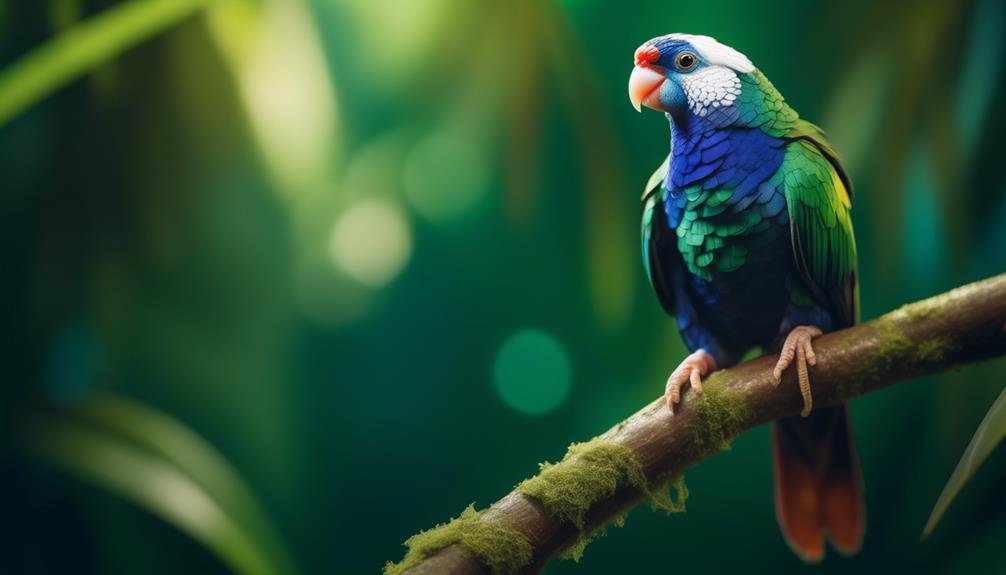
To properly care for the White Capped Pionus and ensure their well-being and longevity, it's important to understand their size and weight.
These enchanting forest companions are medium-sized birds, measuring around 10 inches in length and weighing approximately 8 ounces.
Their physical appearance includes a distinctive white cap on the top of their head, a white crown, and a spot under their chin. Their plumage is primarily green, with blue on the wings and tail, while their breast feathers display a dim blue color.
Feather Coloration
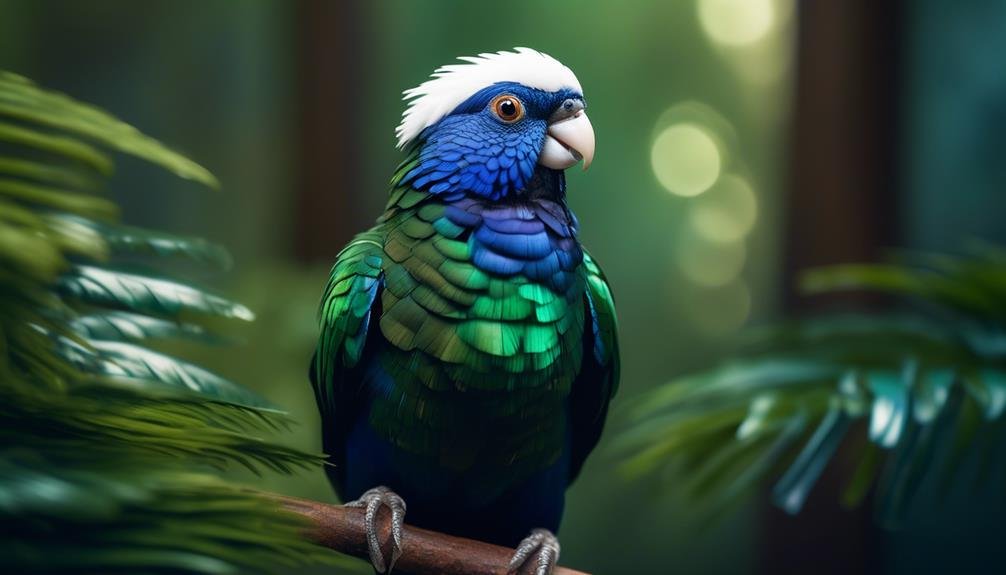
Feather coloration in the White Capped Pionus mesmerizes with its vibrant hues of green, blue, and red. Their breast feathers display a captivating shade of dim blue, while their back and wings showcase a subtle gradient of green tones. The undertail, on the other hand, is a strikingly bright red.
These colors create a stunning contrast against the bird's white crown and spot under its chin. The plumage of the White Capped Pionus is primarily green, with splashes of blue on the wings and tail. This combination of colors gives the bird a truly enchanting appearance, making it a mesmerizing companion for any forest enthusiast.
Range and Distribution
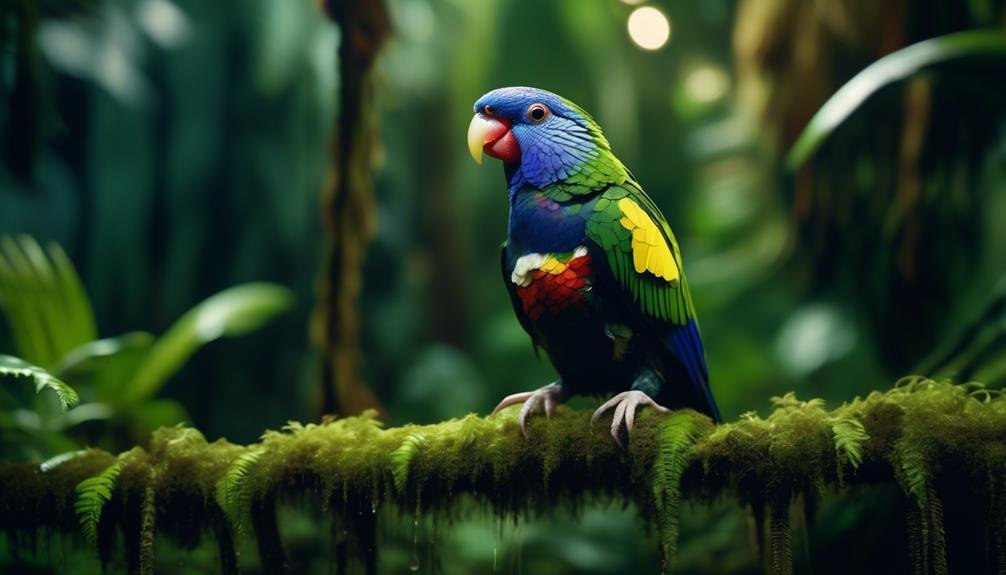
As we shift our focus to the range and distribution of the White Capped Pionus, let's explore where these enchanting forest companions can be found in the wild.
Native to the forests of Central and South America, the White Capped Pionus can be found in countries such as Costa Rica, Panama, Colombia, and Ecuador. They prefer humid and subtropical environments, inhabiting both lowland and montane forests.
Additionally, they can be found in secondary growth and agricultural areas.
Their populations are stable in most of their range, but habitat loss due to deforestation remains a primary threat.
It's important to appreciate and protect the natural habitats where these captivating birds reside.
Social Behavior
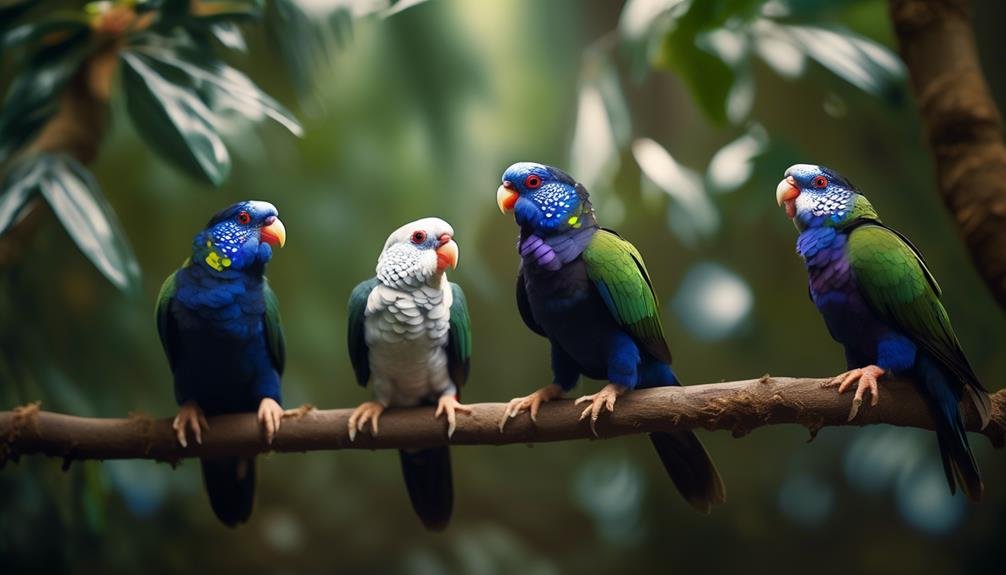
White Capped Pionus are known for their highly social nature and strong pair bonds with their mates. They're playful, affectionate, and enjoy interacting with their owners and playing games. These birds can develop a strong bond with their trusted person or household.
They communicate through a range of vocalizations, including whistling and mimicking sounds. Additionally, they're intelligent and enjoy interactive toys and puzzles. While they can be territorial and show aggression towards intruders, they're generally friendly and sociable.
White Capped Pionus thrive in environments where they can engage in social interactions, making them excellent companions for individuals or families who are willing to provide them with the attention and interaction they need.
Vocalizations and Communication
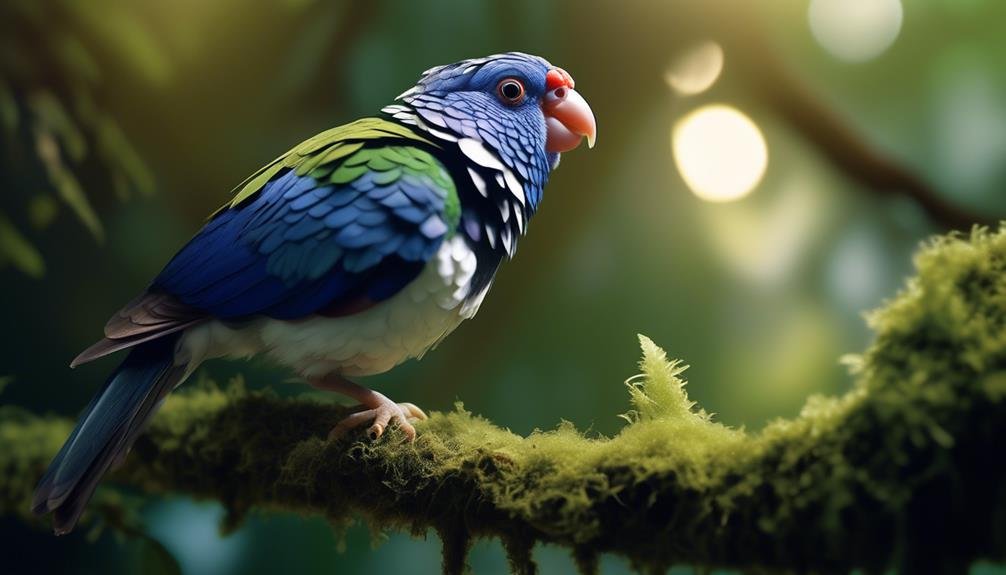
To understand the White Capped Pionus' vocalizations and communication, it's essential to observe their diverse range of sounds and interactions.
These enchanting birds are highly vocal and use a variety of calls to communicate with their flock members and express their emotions. From soft whistles and chirps to loud squawks and screeches, their vocal repertoire is extensive.
They can mimic sounds, including human speech, and enjoy engaging in interactive conversations with their owners. Additionally, their body language, such as head bobbing and wing fluttering, further enhances their communication skills.
It's fascinating to witness the intricate ways in which White Capped Pionus convey their thoughts and feelings, making them captivating forest companions.
Omnivorous Diet
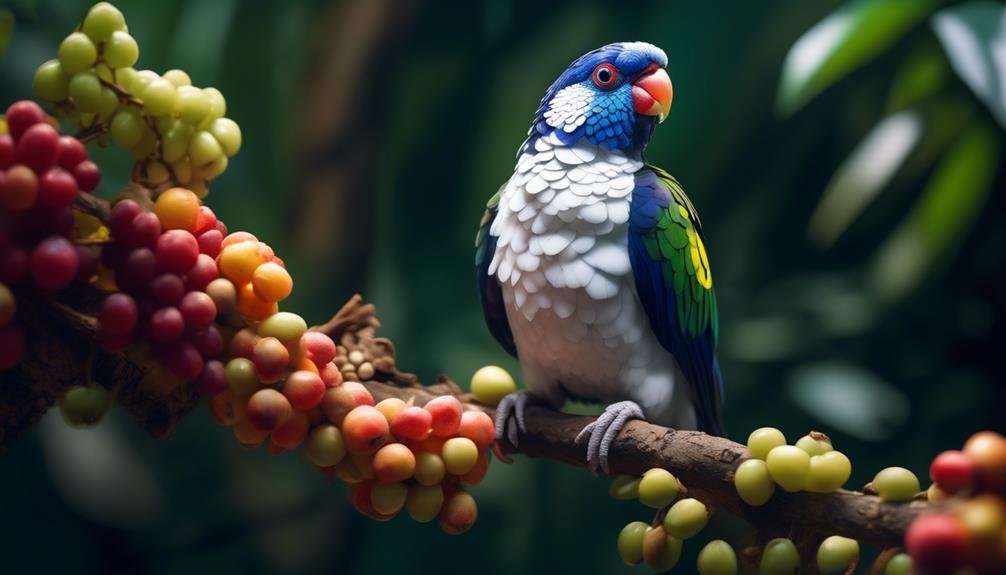
With their diverse diet consisting of fruits, seeds, nuts, berries, and even small invertebrates, the White Capped Pionus is well-adapted to thrive as an omnivorous species in its natural habitat. This omnivorous diet provides the necessary nutrients for their overall health and well-being.
Here are some key points about their diet:
- Fruits, seeds, nuts, and berries form the foundation of their diet, providing essential vitamins, minerals, and antioxidants.
- They also consume flowers, buds, and leafy greens, which contribute to their overall nutritional needs.
- Occasionally, they supplement their diet with insects and small invertebrates, which provide a source of protein.
- A balanced diet is crucial for their optimal health, so it's important to offer a variety of foods to meet their dietary requirements.
- White Capped Pionus particularly enjoy eating corn, especially corn on the cob, which can be offered as a special treat.
Threats and Conservation Efforts
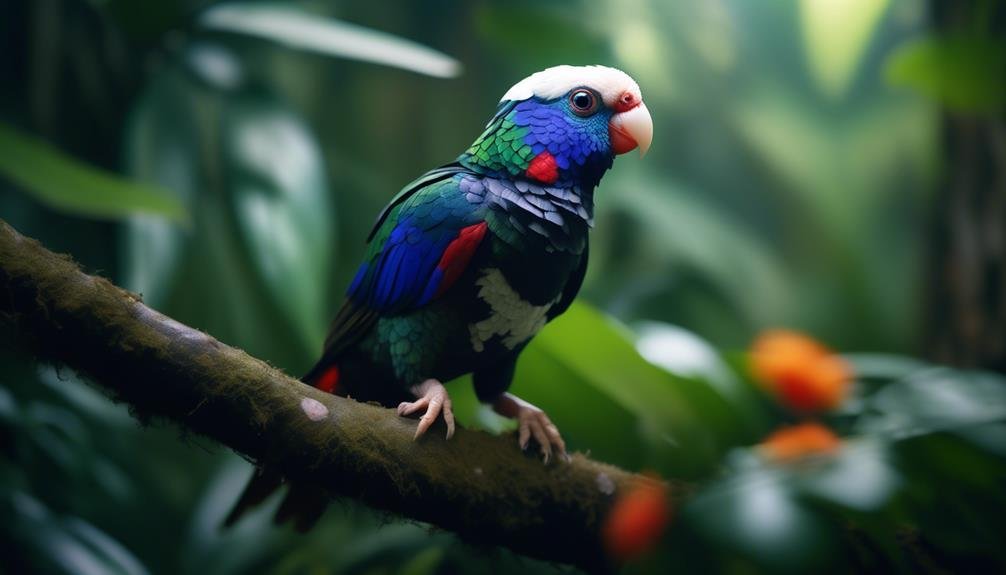
As we shift our focus to the topic of conservation, it's important to address the threats faced by the White Capped Pionus and the efforts being made to protect this enchanting forest companion.
The primary threat to the White Capped Pionus is habitat loss due to deforestation. As forests are cleared for agriculture and urbanization, the bird's natural habitat is shrinking.
However, conservation efforts are being made to protect this species. Captive breeding programs help maintain genetic diversity and ensure the survival of the species.
Additionally, trade in White Capped Pionus is regulated by CITES to prevent overexploitation.
These conservation efforts aim to safeguard the future of this beautiful bird and ensure that it continues to enchant us with its presence in the forests of Central and South America.
Lifespan and Care Tips
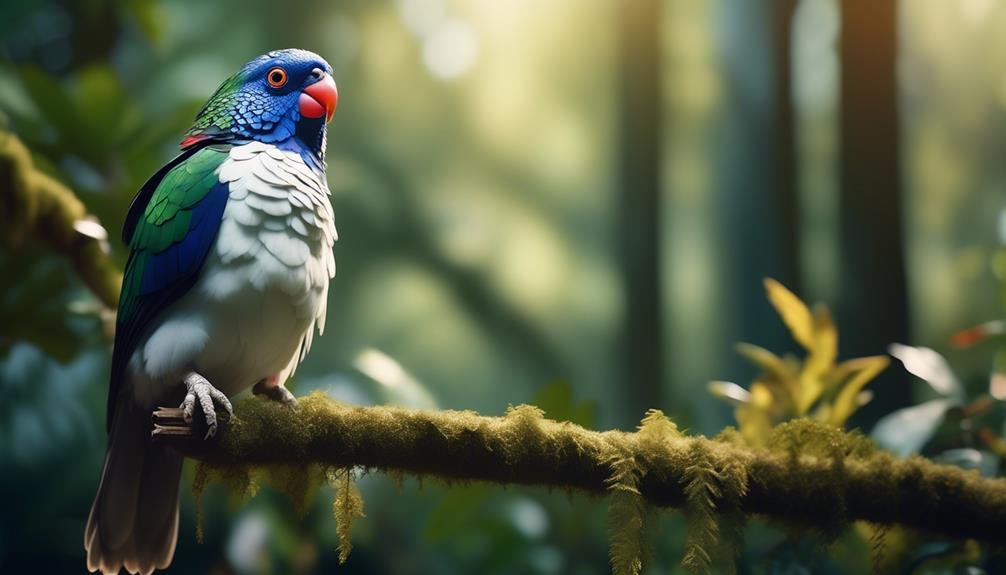
Caring for the White Capped Pionus and ensuring its long lifespan requires attention to its unique needs and providing a supportive environment. Here are some care tips to keep in mind:
- Diet and Nutrition:
- Offer a balanced diet consisting of fruits, seeds, nuts, berries, leafy greens, and occasionally insects.
- Include corn, particularly corn on the cob, as they relish it.
- Cage and Environment:
- Provide a spacious cage with plenty of room for the bird to move around.
- Include perches of varying sizes and materials to promote foot health.
- Ensure the cage is placed away from drafts and direct sunlight.
- Offer toys and puzzles to keep them mentally stimulated.
Frequently Asked Questions
Can White Capped Pionus Learn to Talk and Mimic Human Speech?
Yes, White Capped Pionus can learn to talk and mimic human speech. They are intelligent birds that enjoy communicating through a range of vocalizations, including whistling and mimicking sounds.
How Do White Capped Pionus Communicate With Each Other in the Wild?
White Capped Pionus communicate with each other in the wild through a range of vocalizations, including whistling and mimicking sounds. They use these sounds to establish territory, attract mates, and communicate with their flock.
Are White Capped Pionus Suitable Pets for Families With Children?
Yes, White Capped Pionus can be suitable pets for families with children. They are playful and enjoy interacting with their owners. However, supervision is necessary to ensure the safety of both the bird and the child.
What Are Some Common Health Issues That White Capped Pionus May Experience?
White Capped Pionus may experience common health issues such as respiratory infections, feather plucking, and obesity. Regular vet check-ups, a balanced diet, and a clean environment are crucial to ensure their well-being.
What Are the Legal Requirements for Owning a White Capped Pionus as a Pet?
To legally own a White Capped Pionus as a pet, you should check the specific regulations in your area. Some countries may require permits or licenses, and trade in these birds is regulated to prevent overexploitation.
Are White Capped Pionus and Red Sided Parrots Suitable to Keep as Companion Birds Together?
Yes, White Capped Pionus and Red Sided Parrots can be suitable companion birds. The vibrant red parrot beauty of the Red Sided Parrot contrasts nicely with the subtle colors of the White Capped Pionus, creating a visually appealing pair. Both species have similar care requirements, making it easier to care for them together.
Conclusion
In conclusion, the White Capped Pionus is truly an enchanting forest companion. With its stunning physical characteristics, captivating behavior, and strong bonds with humans, this medium-sized bird is sure to bring joy and charm to your life.
From its mesmerizing colors to its playful interactions and wide range of vocalizations, the White Capped Pionus is a delightful companion. By understanding its habitat, feeding habits, conservation status, and care requirements, you can ensure a long and fulfilling relationship with this exotic bird.

